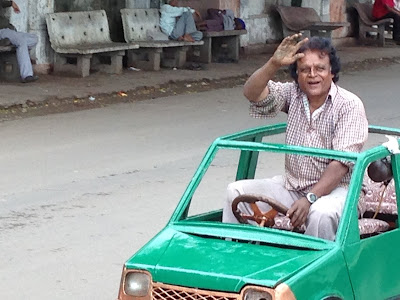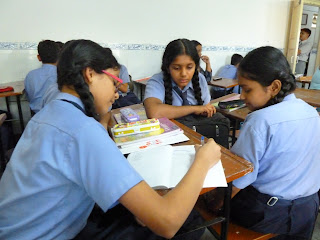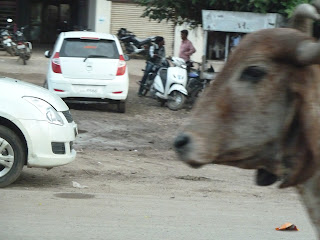Working through our analysis and starting to create the
final report we felt we needed to meet some of the parents to get a better
perspective of the environment in which the children are brought up.
According to our clients, the best place for this would be
the local medical centre and when we arrived there we got a little tour around
the facility.
For 6 years, Essar has been running this centre in Jakhar,
one of the villages in the vicinity of the refinery, and provides free medical
services to anyone who needs it. There is no registration fee, consultation
with one of the 3 doctors as well as any medication handed out is free of
charge. The centre also runs a lab to conduct blood tests (e.g. for malaria or dengue)
and operates two ambulances which can be called – again, free of charge – 24/7.
Basic medical services are provided at the centre (and Gica tried it and had
the bandaging on his poor toe changed and was very pleased with the service he
received); only the more serious cases are referred to one of the two local
hospitals.
It’s really impressive and encouraging to see places like
this in what is a very poor part of the country. Since opening in 2007, the
centre has been able to serve more than 250,000 people and it was clear how
much the local communities value the facility and the difference it makes ->
since the centre opened, the death rate for malaria in the area is zero!
We were able to talk to 3 sets of parents during our visit
to the centre and got a much better view of their priorities.
 We asked why the children dropped out of the education
system after 8th standard (none of the parents we spoke to send their children
to school after 8th standard, i.e. when the children are 13 or 14
years). The main reasons cited for this were that the children were unable to
travel to the nearest 9th-12th standard school (too far away, no means of
transportation,…), the parents required their children to support the family;
particularly girls were expected to help with child care and/or got married at
an early age (and the daughters of the families we spoke to, had left school in
6th standard already), but boys also drop out frequently after 8th
standard in order to get a job. Parents also confirmed that they would prefer
the public education over government schools, but that they simply could not
afford to send their children to these schools. All the parents we spoke to would
first and foremost stress the fact that they had no money to keep their
children in education, pay for their food or clothes (officially, school
uniforms should be provided for free to all children, but this does not seem to
be the case for all the schools around the Vadinar refinery). Midday meals are
given out in all the schools we visited and we were told that in some cases,
this is the only meal a child would get each day.
We asked why the children dropped out of the education
system after 8th standard (none of the parents we spoke to send their children
to school after 8th standard, i.e. when the children are 13 or 14
years). The main reasons cited for this were that the children were unable to
travel to the nearest 9th-12th standard school (too far away, no means of
transportation,…), the parents required their children to support the family;
particularly girls were expected to help with child care and/or got married at
an early age (and the daughters of the families we spoke to, had left school in
6th standard already), but boys also drop out frequently after 8th
standard in order to get a job. Parents also confirmed that they would prefer
the public education over government schools, but that they simply could not
afford to send their children to these schools. All the parents we spoke to would
first and foremost stress the fact that they had no money to keep their
children in education, pay for their food or clothes (officially, school
uniforms should be provided for free to all children, but this does not seem to
be the case for all the schools around the Vadinar refinery). Midday meals are
given out in all the schools we visited and we were told that in some cases,
this is the only meal a child would get each day.
Despite all of this, the parents we spoke to said that they
felt is was important for their children to have a good education and said they
were not satisfied with the education provided at the public schools and the skill
levels attained by their children. Some parents send their children to some
sort of tuition (in the case of the parents we met today, this was an after-school
club run by the local Muslim community) and we will try to find out more about
these additional opportunities for education and learning.
In addition to talking to the parents, we were also able to
meet with the district representative responsible for the 1,371 (!) primary schools
in the Jamnagar
district. From this meeting, it is clear though that the ability (or
willingness) to improve the situation through the district is limited. Most of
the education is apparently regulated by the state government and can not be
influenced by the district. Also, the district official rarely engages directly
with any of the schools (given the number of schools in his remit this is
understandable) and only gets involved in payroll and any serious issues (such
as sexual harassment). But even then, his room for manoeuvre was limited, as
according to him he can not fire but only transfer teachers to other schools.
There are currently ca. 2,000 teacher posts vacant in the Jamnagar district (which does not seem to be
an attractive place for teachers, so they prefer postings in other areas) and there
was no initiative/plan to address this and/or use positive recognition to
reward outstanding teachers.
While this may sound depressing it really helps us to understand
the environment in which the schools operate much better and will enable us to
develop recommendations that are likely to work in the setting here in Vadinar.
When we are not working, we try to get together as a team
and yesterday had the brilliant excuse to do so in order to celebrate Anton’s
birthday
In India,
birthdays are apparently not a big deal, so the hotel was surprised when we mentioned
that we wanted to organise a little party. They then fully embraced the idea
though and went out of their way to organise a delicious birthday cake
(chocolate!) and decorated the room beautifully! They also found a place were
we could order “non-veg” take-away (i.e. chicken) and Elyse and Gica ventured
to the “alcohol place” during lunch break to ensure our supplies were stocked
up, so we indulged in a really nice meal yesterday evening!
This weekend we are invited to Essar’s 1-year of
volunteering celebration and will also take part in a mural-painting
volunteering activity at one of the local schools. Hopefully you also have
great plans for the weekend and a nice time!



















































